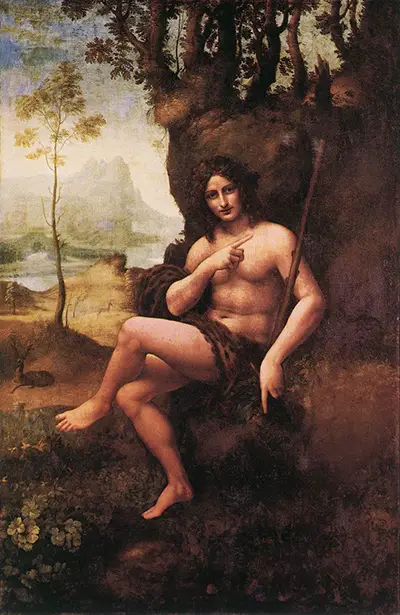However, the painting is said to have been completed by one of da Vinci's followers, perhaps Cesare da Sesto, Francesco Melzi, Marco d'Oggiono, and Cesare Bernazzano, although the deterioration of the painting means it is difficult to decipher the true artist. Many, however, agree that it was resurrected by a 'Lombard painter': an Italian painter around in the 17th century with a similar style to Leonardo da Vinci, and who probably also followed his work.
The original drawing was of John the Baptist, but in 1693 was overpainted as Bacchus. Da Vinci's drawing contained a cross-like staff which was later transformed through the removal of the horizontal bar completing the cross shape, into a thyrsus (a staff decorated with vines or ivy, pine cones, berries and grapes) to symbolise Bacchus being the god of the vine and of drinking.
Another change that was made following the original was the panther skin draping over Bacchus and keeping his modesty. This is perhaps one of the most obvious indicators as to the John the Baptist original, since Bacchus was often portrayed as a drunkard with little modesty or restraint. Instead, he was usually depicted with animal skins and seen as somewhat 'primal'. The animal skin in the painting was initially the famous fur robe of John the Baptist, but the added leopard spots allowed the transformation into the more primal and pagan symbol. The crown of vine leaves and grapes were also a later addition, and these were also common symbols used to portray the Roman god of wine.
The pointed finger is also a common representation of John the Baptist, but the other hand of Bacchus which is holding the thyrsus and pointing towards the ground suggests a stronger connection to the earth and the vines, plants and fruit that is conceived from it. Bacchus was also the god of fertility as well as wine, which is why much of the symbolism associated with him are plants and vines.
The background of the painting lacks the descriptive characteristics that Leonardo da Vinci often included in his work which is another indication that the original drawing had been resurrected and transformed by a different artist. It is likely to have portrayed John the Baptist in a desert surrounding before the landscape was changed later to an idyllic setting to suit the godlike Bacchus persona.
Furthermore, unlike many of da Vinci's other work, no preliminary drawings were found which was somewhat unusual. However, many still ascribe da Vinci as the artist of this work, since this painting has been built upon his original drawing. As there are no further clues to who this later follower and artist may be, the majority of critics agree that the Bacchus painting should still be accredited to its fundamental creator, despite its dramatic evolution.


